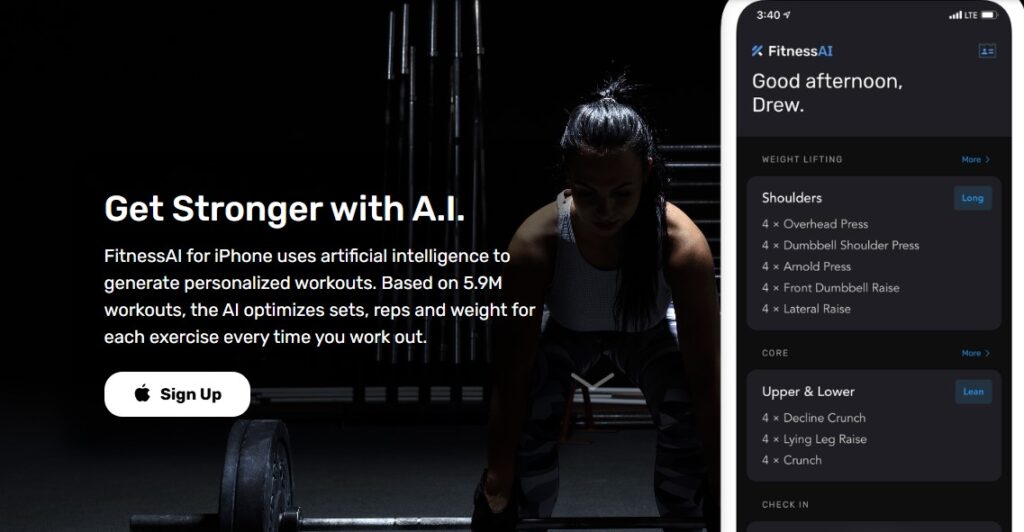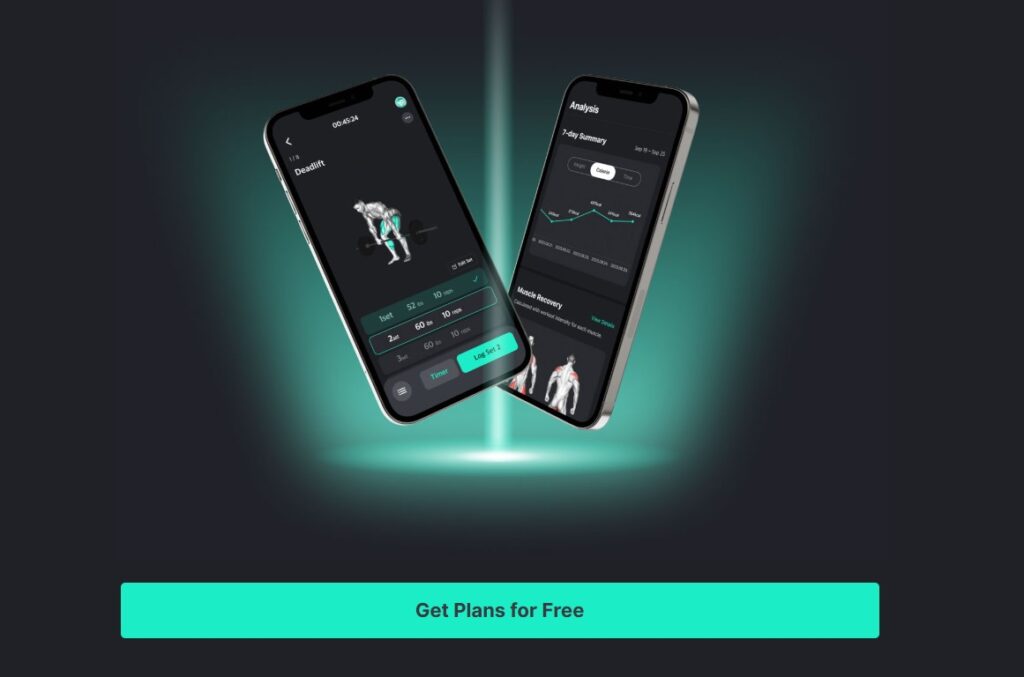FitnessAI vs Gyroscope App: Which Fitness Tracker Reigns Supreme in 2024?
In a world where fitness apps flood the market, choosing the right tool can feel like searching for a needle…

In a world where fitness apps flood the market, choosing the right tool can feel like searching for a needle in a digital haystack!
I’ve tried countless options myself, from apps that track every calorie to ones that analyze sleep patterns, and two have consistently risen above the noise:
FitnessAI vs Gyroscope App. This comprehensive comparison will show you how these innovative platforms stack up, helping you pick the perfect companion to elevate your workout routine, improve habit-building, and supercharge your overall well-being.
FitnessAI Overview – A Personalized Workout Companion
I remember when I first started using FitnessAI, I felt like I had stumbled onto a secret personal trainer who lived right in my phone. It’s powered by an AI-driven engine that carefully analyzes your exercise history, then suggests progressive overload routines so you push your limits in a safe, data-driven way.

At first, I had my doubts—could a digital fitness tool really guide me better than my old sweat-stained workout journal? FitnessAI surprised me by using all sorts of fitness metrics, from strength progress monitoring to detailed workout tracking metrics, ensuring that each session feels like it’s been custom-tailored to my body’s needs.
The UI is super clean and kind of reminds me of a sleek, modern gym floor—everything flows well, and I don’t waste time clicking around aimlessly. I’ve even found a few features that I initially overlooked, like subtle habit-building tips to keep me consistent on days when I’m feeling lazy.
Below is a quick comparison chart I created based on my personal experience with FitnessAI, scoring each feature from 1 to 10 (10 being highest):
| Feature | Score (FitnessAI) |
|---|---|
| Personalized Strength Training | 9 |
| Workout Library Variety | 8 |
| User Interface & Navigation | 9 |
| Data-Driven Goal Setting | 8 |
| Wearable Integration | 7 |
| Community Challenges | 6 |
| Stress Management Tools | 5 |
Gyroscope App Overview – A Holistic Health Ecosystem
When I first tried Gyroscope, I was instantly struck by how it looked more like a lifestyle analytics dashboard than a simple fitness tracker. Instead of just pumping out exercise recommendations, it gives you a 360-degree snapshot of your overall health, from your daily steps and heart rate variability to your nutrition guidance and even stress management features.
I have to admit, the first time I synced my Apple Watch, I felt a bit overwhelmed—so much data, so many lifestyle analytics, but I eventually got the hang of it. What really impressed me was how Gyroscope encourages balanced habit formation, not just focusing on brute strength or cardio training guidance, but also on sleep monitoring tools and stress reduction strategies that impacted how I felt each morning.
The interface is visually stunning, and the community engagement is pretty strong—just scrolling through others’ achievements is often enough to get me off the couch. Even on days I’d rather be napping, I’ll catch a glimpse of my daily metrics visualization and think, “Alright, time to move!”
Check out the chart for Gyroscope, using the same scoring approach:
| Feature | Score (Gyroscope) |
|---|---|
| Personalized Strength Training | 7 |
| Workout Library Variety | 6 |
| User Interface & Navigation | 8 |
| Data-Driven Goal Setting | 9 |
| Wearable Integration | 9 |
| Community Challenges | 8 |
| Stress Management Tools | 9 |
From this first-hand experience, FitnessAI feels like a focused personal trainer alternative, while Gyroscope functions as an all-in-one health tracking software that covers almost every aspect of your life. Both have their quirks, and I’ve made my share of mistakes fumbling through their settings, but ultimately, each one can help you become a more informed, well-rounded athlete.
FitnessAI vs gyroscope app: Key Feature Comparisons – Metrics, Analysis, and Customization
When I first started digging deep into both apps, I kept wondering:
“Who’s giving me better analytics and more personalized plans?” FitnessAI’s data-driven fitness programs focus heavily on progressive overload, carefully increasing weight or reps so you build muscle and strength steadily. Gyroscope takes a holistic angle, aggregating everything from calorie tracking to heart rate variability, helping me spot trends in my lifestyle that I never knew were influencing my workouts.
FitnessAI’s metrics visualization felt a bit too narrowly focused on strength training gains, whereas Gyroscope’s approach allowed me to link poor sleep patterns to weaker performance in my morning workouts. Still, FitnessAI’s data-driven goal setting was remarkably accurate, offering exercise recommendations that felt fine-tuned, while Gyroscope delivered more lifestyle analytics that encouraged me to tweak my daily routine, diet, and rest habits.
Below is a quick table comparing how each app handles core features related to metrics and customization, scored from 1 to 10 (10 being highest):
| Key Features | FitnessAI Score | Gyroscope Score |
|---|---|---|
| Exercise Recommendations | 9 | 8 |
| Lifestyle Analytics | 6 | 9 |
| Data Visualization | 8 | 8 |
| Workout Customization | 9 | 7 |
| Nutrition Guidance | 5 | 8 |
If you’re simply chasing raw strength numbers, FitnessAI will make your path crystal clear. But if you’re all about holistic wellness, you’ll likely appreciate Gyroscope’s ability to unify your sleep monitoring tools, stress management features, and nutrition insights into a single picture, guiding you toward balanced habit formation. Ultimately, it’s about deciding which metrics matter most to you.
User Experience and Interface – Navigating Your Fitness Journey
My first week with FitnessAI, I was impressed by how quickly I could jump into a workout. The user interface is clean and minimal, meaning I wasn’t stuck hunting through complicated menus—just pick a muscle group and you’re off. However, if you’re a data nerd like me, you might crave more screens, more charts, and deeper dives into progress graphs.
Gyroscope has that sleek “health tracking software” vibe with a ton of lifestyle analytics right upfront. I almost felt like a health detective, piecing together clues about my sleep, stress, and calorie intake. This can feel a bit overwhelming on day one, but once you get the hang of it, it’s super rewarding.
To break it down, here’s a comparison table highlighting elements of user experience and interface, scored from 1 to 10:
| UX/UI Elements | FitnessAI Score | Gyroscope Score |
|---|---|---|
| Ease of Navigation | 9 | 7 |
| Visual Appeal | 8 | 9 |
| Loading/Responsiveness | 9 | 8 |
| Data Accessibility | 7 | 9 |
| Community Engagement | 6 | 8 |
If you’re a visual learner who thrives on seeing the big picture, Gyroscope’s colorful dashboards might make you fall in love.
If you prefer minimalism and getting straight to your next workout, FitnessAI’s focused design could be perfect. I’ve definitely had my moments of confusion when navigating Gyroscope’s more advanced features, but nothing a quick browse through the community forums couldn’t fix.
In the end, it’s about choosing the platform that supports your workflow—whether that’s hitting the gym floor ASAP or slowly sipping coffee while reviewing last night’s sleep data before deciding how hard to push today.
Pricing and Subscriptions – Finding Value in Your Investment
When I first looked into FitnessAI’s pricing, I admit I was a bit hesitant—shelling out monthly cash for a digital fitness tool made me question how much bang I’d really get for my buck. Fortunately, FitnessAI offers flexible subscription plans, often with free trials, so you can test out the personalized strength training and see if it’s worth the recurring fee.
In my experience, FitnessAI’s monthly plan hovered around the same price as a couple of fancy coffees, making it pretty affordable considering the quality of data-driven fitness programs you get. But I’d say the annual plan often provides the best value, especially if you’re committed to your athletic performance metrics and plan to stick with it long-term.

On the flip side, Gyroscope tends to be a bit pricier, and I remember wincing slightly when I saw the cost compared to your average fitness app. Yet, Gyroscope’s subscription comes with a holistic wellness platform that includes everything from nutrition guidance to stress management features, so if you’re all about that well-rounded health journey, it might feel like money well spent.
Below is a quick pricing/value comparison table based on my personal take, scoring from 1 to 10 (10 being best value for cost):
| Pricing & Value | FitnessAI Score | Gyroscope Score |
|---|---|---|
| Overall Affordability | 9 | 7 |
| Free Trial Availability | 8 | 8 |
| Feature Depth vs. Cost | 8 | 9 |
| Annual vs. Monthly Savings | 9 | 8 |
| Refund/Support Policies | 8 | 8 |
If you’re tight on cash but still want personalized exercise plans without hiring a personal trainer, FitnessAI’s more budget-friendly approach might be your best bet. But if you see your fitness journey as part of a broader self-improvement lifestyle—and can afford a few more bucks—then Gyroscope’s integrated health tracking software is totally worth considering.
Integration with Wearables and Other Health Tools
My first run with FitnessAI felt like a solo gig until I realized I could connect it to my Apple Watch. Suddenly, all those steps, my heart rate, and even my body composition analysis data flowed into one ecosystem, giving me a clearer picture of my progress. However, FitnessAI’s integration options tend to be more straightforward rather than wide-ranging—think big names like Apple’s ecosystem, not necessarily every new tracker on the market.
Gyroscope seems to play nice with almost everything I tried to throw at it—Fitbit, Garmin, Apple Watch, and even meal-tracking apps like MyFitnessPal. That meant I could easily sync steps, heart rate, and calorie tracking into a single dashboard, enabling me to identify how my daily step count correlates with my sleep patterns or how nutrition guidance impacts my recovery.
Below is a quick chart comparing device compatibility and integration depth, scored from 1 to 10:
| Integration Factors | FitnessAI Score | Gyroscope Score |
|---|---|---|
| Apple Watch Integration | 9 | 9 |
| Fitbit/Garmin Compatibility | 5 | 8 |
| Calorie/Nutrition App Sync | 6 | 9 |
| Heart Rate & Sleep Data Sync | 7 | 9 |
| Overall Ecosystem Support | 6 | 9 |
If you’re rocking an Apple Watch and just want basic wearable integration, FitnessAI gets the job done nicely. But if you’re more of a health data explorer who uses multiple trackers and apps, Gyroscope’s flexible integrations let you bring all your biometric insights together. It’s a bit like having a master control panel for your entire health journey, guiding you toward better balanced habit formation and helping you connect the dots between what you do in the gym and how you feel throughout the day.
User Reviews and Community Feedback – Real Voices, Real Insights
Many FitnessAI community forum users reported that the app helped them overcome persistent strength plateaus, as I discovered while browsing the comments. I also noticed some mild frustration from individuals who craved more nutrition guidance and habit-building apps integration, but most agreed the AI-driven workouts delivered real results.
Meanwhile, Gyroscope’s users seemed excited about the holistic wellness platform approach, often raving about how tying together their sleep monitoring tools, calorie tracking, and stress management features allowed them to discover hidden connections in their daily routines. I read testimonials from folks who realized that their late-night Netflix binges were tanking morning performance, or that their stress levels soared after skipping lunch, and these insights empowered them to make better decisions.
I also saw a few gripes from beginners who felt overwhelmed by Gyroscope’s abundance of lifestyle analytics right out of the gate. Some mentioned that they needed a couple of weeks to fully understand data visualization and figure out how to leverage all those metrics for balanced habit formation.
Below is a user sentiment comparison table based on my personal interpretation of feedback, using a simple Positive/Neutral/Negative scale:
| Aspect | FitnessAI User Sentiment | Gyroscope User Sentiment |
|---|---|---|
| Workout Effectiveness | Positive | Positive |
| Ease of Use | Positive | Neutral |
| Data Depth | Neutral | Positive |
| Community Challenges | Neutral | Positive |
| Holistic Wellness Focus | Neutral | Positive |
From what I’ve seen, FitnessAI enthusiasts are often hardcore gym-goers who value strength progress monitoring and progressive overload. Gyroscope fans tend to be the well-rounded health seekers, eager to improve their entire lifestyle.
Everyone makes a few mistakes along the way—I’ve personally tried to sync the wrong wearable device once or twice, and ended up scratching my head at the weird metrics—so don’t be surprised if you hit a learning curve. Both communities, however, are fairly responsive, so posting questions in forums or chatting in support groups can bring quick tips and solutions.
Making Your Choice – Which App Fits Your Goals Best?
As I sat down to reflect on my own experience, I kept thinking, “What do I actually need right now?”
If you want laser-focused strength training apps that hand you the exact sets, reps, and progression to crush your gym goals, FitnessAI is the clearer choice. It’s like a personal trainer alternative that focuses on building muscle, improving form, and boosting athletic performance metrics without burying you in too much extra fluff.
On the other hand, if your goal is to become a healthier human being overall—sleep better, eat smarter, and reduce stress—then Gyroscope’s holistic wellness platform fits the bill. This isn’t just a digital fitness tool; it’s a health tracking software that integrates nutrition guidance, lifestyle analytics, and stress management features to paint a comprehensive picture of who you are and how you move through life.
Here’s a quick final comparison table to summarize which app might suit different personas, scoring suitability from 1 to 10 (10 being a perfect match):
| User Type | FitnessAI (Score) | Gyroscope (Score) |
|---|---|---|
| Strength-Focused Gym Enthusiast | 10 | 7 |
| Holistic Health Explorer | 6 | 10 |
| Minimalist Data Lover | 9 | 7 |
| Data-Driven Lifestyle Optimizer | 7 | 10 |
| Budget-Conscious Beginner | 9 | 7 |
If you’re still unsure, consider leveraging each app’s free trial to test the waters. I’ve personally found that a quick week or two with a new platform reveals a lot about whether it truly fits your style. After all, the best solution is the one that you actually want to open daily—no one likes a fancy app icon gathering dust on their home screen.
Conclusion
Your choice depends on what you prioritize. Do you need a platform that offers a personal trainer alternative with minimal fuss? Or do you crave a holistic wellness platform that covers every angle of your health, tying calorie tracking, heart rate insights, and habit-building apps into one neat package?
I’d say, give both a try. Testing them firsthand can reveal which experience feels more natural, more motivating, and more aligned with your personal journey. Over time, you’ll spot patterns, discover what works best, and maybe even get a kick out of seeing your body composition analysis improve while you track your sleep monitoring tools side by side. Whichever path you take, remember that consistency, curiosity, and patience are the keys to becoming your best, healthiest self.
